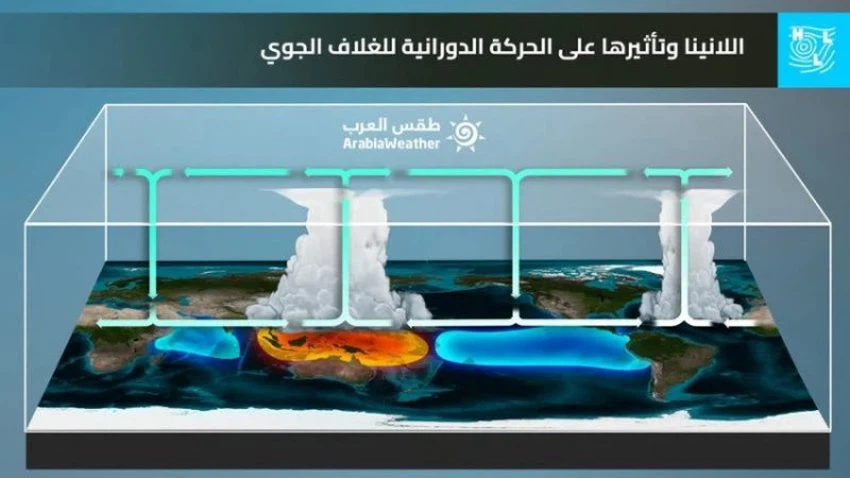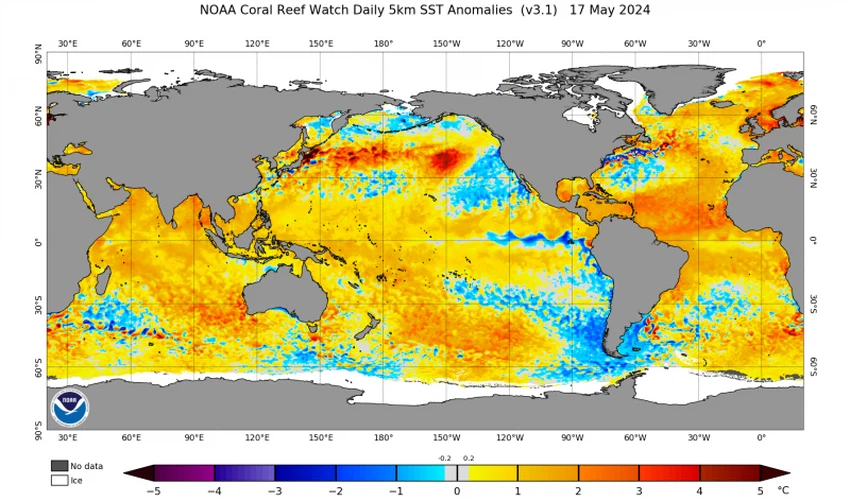Under surveillance: The waters of the tropical part of the Pacific Ocean are witnessing continuous cooling. Does this herald the return of the growth of the La Nina phenomenon?
Arabia Weather - After following up on the latest computer modeling outputs regarding the deviation of the temperature of water bodies from averages, specialists at the Arab Regional Weather Center said that the region located on the equator of the Pacific Ocean, specifically off the coast of Peru, has recently witnessed a clear cooling of the water surface temperature, as it has decreased from its averages by an amount It ranges between one and two degrees. This means that a new climate cycle has begun to appear in the waters of the Pacific Ocean, which is an increase in the La Nina climate phenomenon, which may continue in the coming months. What is this phenomenon and what is the difference between it and the El Nino phenomenon?
What is the difference between El Nino and La Nina phenomena?
In detail, “El Niño” and “La Niña” are two climate phenomena that occur in the tropical region of the Pacific Ocean. However, the El Niño phenomenon occurs as a result of the water surface temperature in the Pacific Ocean rising above its normal rate by about half a degree Celsius, while the La Niña phenomenon occurs as a result of temperatures falling below Their rates are in the Pacific Ocean, and the two phenomena lead to a number of strong weather disturbances globally.

During normal conditions in the Pacific Ocean, trade winds blow westward along the equator, carrying warm water from South America toward Asia. To replace this warm water, cold water rises from the depths – a process called upwelling. El Niño and La Niña are two opposing weather patterns that break these natural conditions, and scientists call these phenomena the El Niño-Southern Oscillation (ENSO) cycle. El Niño and La Niña can have global impacts on weather, wildfires, ecosystems, and economies. El Niño and La Niña episodes usually last nine to 12 months, but can sometimes last for years. El Niño and La Niña occur every two to seven years on average, but they do not occur regularly. Generally a regular schedule, but El Niño occurs more frequently than La Niña.
What is the importance of El Niño and La Niña?
Together, El Niño and La Niña form part of a natural cycle that can dramatically affect not only global weather, climate, and ocean conditions but also food production, human health, and water supplies. These systems typically last for about one to two years, with the cycle alternating every three to seven years.
Scientific explanation: What is the La Niña phenomenon in detail and what does this word mean?
Arab weather experts have explained that the term La Niña refers to a large-scale ocean and atmospheric climate phenomenon associated with periodic cooling in sea surface temperatures (SSTs) across the central, eastern and central tropical Pacific Ocean. The La Niña or La Niña phenomenon represents the cold phase of the “ENSO” cycle and means that Ocean water temperatures are cooler than average.

The word La Nina is a Spanish word that means little girl. The La Nina phenomenon is also sometimes called El Viejo. La Nina has the opposite effect to the El Niño phenomenon, as during La Nina events the trade winds are stronger than usual, pushing more warm water toward Asia off the west coast of the Americas.
The La Nina phenomenon may continue during the winter of 2024/2025. What will its impact on the atmosphere and climate of the world and the Levant?
It is likely, God willing, according to the specialists at the Arabia Weather Center, that the La Nina phenomenon may continue during the coming winter season 2024/2025, but it cannot be certain that its effects will be inevitable in terms of its impact on the world’s climate, as all the likely effects are the result of statistical processing processes for years. This phenomenon occurred with the need to emphasize that these climate cycles are only an integral part of giant patterns that drive global weather systems.
- Impact on the global climate, specifically the United States of America
During a La Niña year, cold water in the Pacific Ocean pushes the jet stream northward, leading to drought in the southern United States and heavy rains and flooding in the Pacific Northwest and Canada. During a La Niña year, winter temperatures are warmer than normal in The south is colder than usual in the north, and the La Niña phenomenon could also lead to a stronger and more severe hurricane season than usual as a result of the change that occurs in the movement of warm sea currents, which are considered the primary feeder and fuel for any tropical activity around the world.
Weather forecasters at the center said that the La Nina phenomenon has clear and obvious effects on the northern Indian Ocean, as La Nina conditions increase the flow of the wet eastern tides coming, God willing, from the western Pacific Ocean, passing through the China Sea and reaching the Bay of Bengal, and also raise the water surface temperature in the eastern part of the The Indian Ocean, and these weather conditions provide a fertile and incubating environment for the emergence of tropical conditions in the Bay of Bengal.
- Impact on the climate of the Levant, the Arabian Peninsula, and the Maghreb
Arab weather forecasters believe that the La Nina phenomenon is statistically linked to the intensification of the influence of the Siberian High on the Arabian Peninsula and the Levant during the winter season. The La Nina phenomenon affects the Arab region mostly with a lack of rain in the regions of the Arab Levant, but the opposite happens in the regions of the Maghreb, where rain increases and the temperature drops below its average. The chance of floods and torrents increases in the regions of the Maghreb, while the chance of drought increases in the regions of the Arab Levant as a result of the control of the Siberian high altitude.
The greatest knowledge remains for God Almighty, and everyone proceeds according to his destiny.
Arabia Weather App
Download the app to receive weather notifications and more..



